March 15, 2024
Tamtaki: Street Food Meets Supra
Tbilisi |
Tbilisi -- The Vera district of Tbilisi is bursting with tempting food options, from traditional Georgian feasts to cinnamon rolls and pizza. Read more

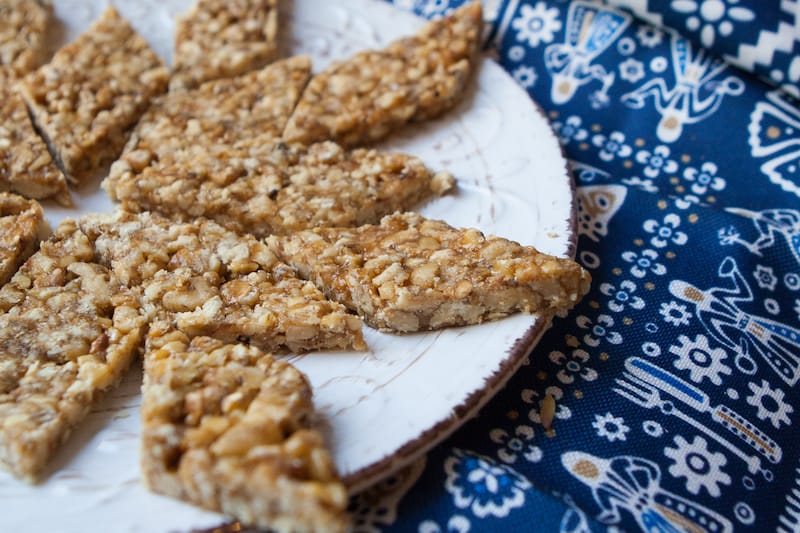 Irma is a trained cook who founded Georgian Flavours, a private cooking school in Tbilisi which she runs with her cousin Bako. The two invited us into Irma’s home to share her family’s gozinaki recipe. Made from just walnuts and honey, the key to this confection is in the cooking technique and choosing quality ingredients.
Ingredients
270g Honey
360g Walnuts
1/4 teaspoon of sugar
Picking the right walnuts is essential: “For gozinaki, we choose exceptional walnuts; they should be white, the highest quality, and whole,” says Irma. “White” is the Georgian term for the highest quality of walnut, so outside Georgia you’ll need to look for plump, whole walnuts which are light brown in color when shelled. The best honey to use is a linden honey, but any light honey without a strong flavor will work. Some cloudiness from natural sugar crystallization is also a good sign of quality in honey.
Irma is a trained cook who founded Georgian Flavours, a private cooking school in Tbilisi which she runs with her cousin Bako. The two invited us into Irma’s home to share her family’s gozinaki recipe. Made from just walnuts and honey, the key to this confection is in the cooking technique and choosing quality ingredients.
Ingredients
270g Honey
360g Walnuts
1/4 teaspoon of sugar
Picking the right walnuts is essential: “For gozinaki, we choose exceptional walnuts; they should be white, the highest quality, and whole,” says Irma. “White” is the Georgian term for the highest quality of walnut, so outside Georgia you’ll need to look for plump, whole walnuts which are light brown in color when shelled. The best honey to use is a linden honey, but any light honey without a strong flavor will work. Some cloudiness from natural sugar crystallization is also a good sign of quality in honey.
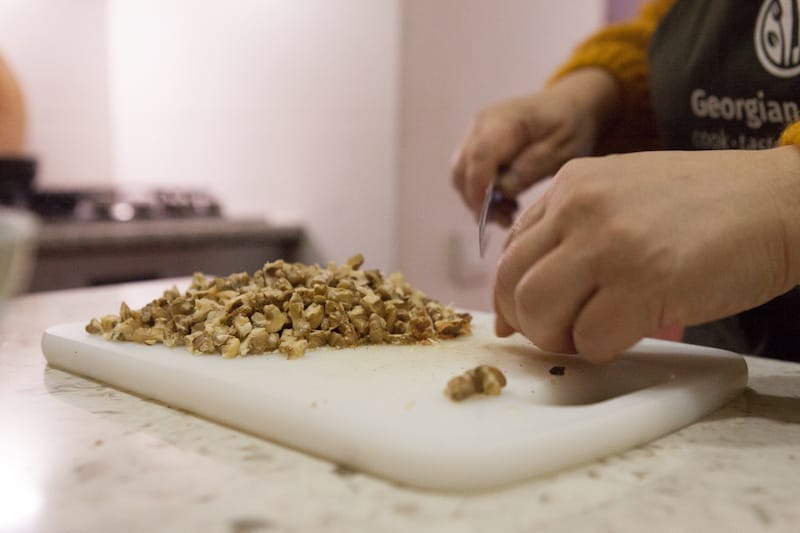 Begin by lightly toasting the walnuts in a pan on a low heat. When you start to smell the walnuts’ fragrance, they’re ready to come off the heat. Next, place the empty pan back on the stove and leave it to warm on a low heat. While you’re waiting you can begin chopping the walnuts, cutting each half into around four small pieces.
Begin by lightly toasting the walnuts in a pan on a low heat. When you start to smell the walnuts’ fragrance, they’re ready to come off the heat. Next, place the empty pan back on the stove and leave it to warm on a low heat. While you’re waiting you can begin chopping the walnuts, cutting each half into around four small pieces.
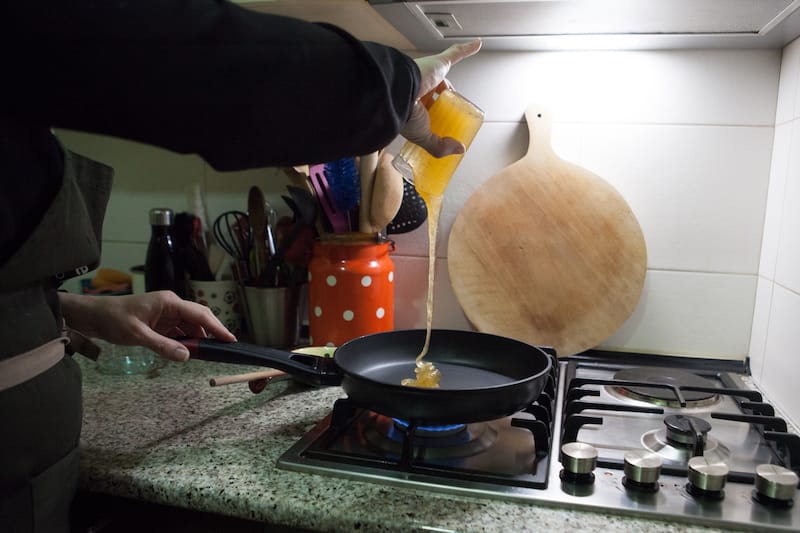 Once the pan is warm again, add the honey and leave it to heat while you finish chopping the walnuts. After about five minutes, when the honey starts to foam and boil, it’s time to add the quarter teaspoon of sugar. “We use a little bit of sugar to help it caramelize,” explains Irma. “But the sugar also affects the color of the gozinaki and makes it darker.” More sugar will also make the gozinaki crunchier.
Once the pan is warm again, add the honey and leave it to heat while you finish chopping the walnuts. After about five minutes, when the honey starts to foam and boil, it’s time to add the quarter teaspoon of sugar. “We use a little bit of sugar to help it caramelize,” explains Irma. “But the sugar also affects the color of the gozinaki and makes it darker.” More sugar will also make the gozinaki crunchier.
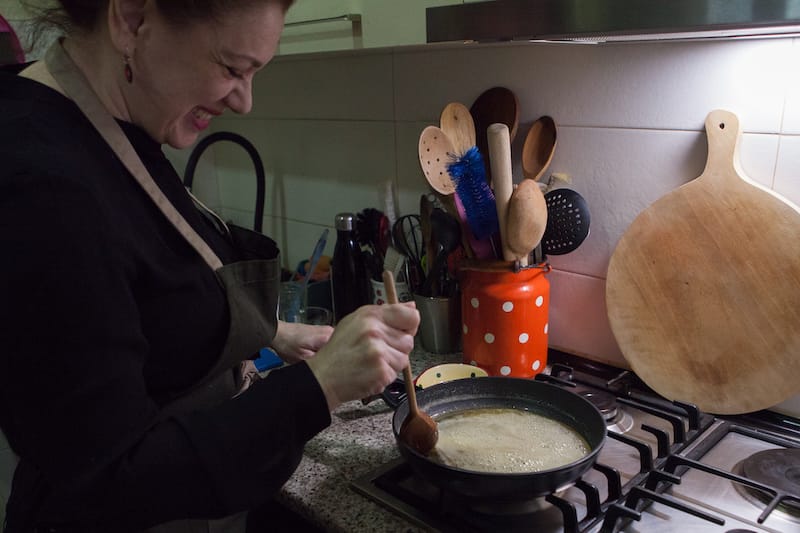 It’s crucial to keep stirring the honey-sugar mix so that it does not catch on the bottom of the pan and burn. The time it takes to caramelize will depend on the type of honey used, but usually it takes around 15 minutes. At this point, it will reach a deeper brown color and start to foam more evenly. To check if your honey is caramelized, Irma recommends taking a small amount of honey out of the pan with your spoon and letting a couple of small drops fall into a clear jug of cold water. If the drops remain intact, it’s ready. If your drops spread, the honey needs a little longer. The drops will sink and coagulate near the bottom, so it’s useful to use a clear container for this step. At this stage, your kitchen will also be filled with a deliciously sweet fragrance.
It’s crucial to keep stirring the honey-sugar mix so that it does not catch on the bottom of the pan and burn. The time it takes to caramelize will depend on the type of honey used, but usually it takes around 15 minutes. At this point, it will reach a deeper brown color and start to foam more evenly. To check if your honey is caramelized, Irma recommends taking a small amount of honey out of the pan with your spoon and letting a couple of small drops fall into a clear jug of cold water. If the drops remain intact, it’s ready. If your drops spread, the honey needs a little longer. The drops will sink and coagulate near the bottom, so it’s useful to use a clear container for this step. At this stage, your kitchen will also be filled with a deliciously sweet fragrance.
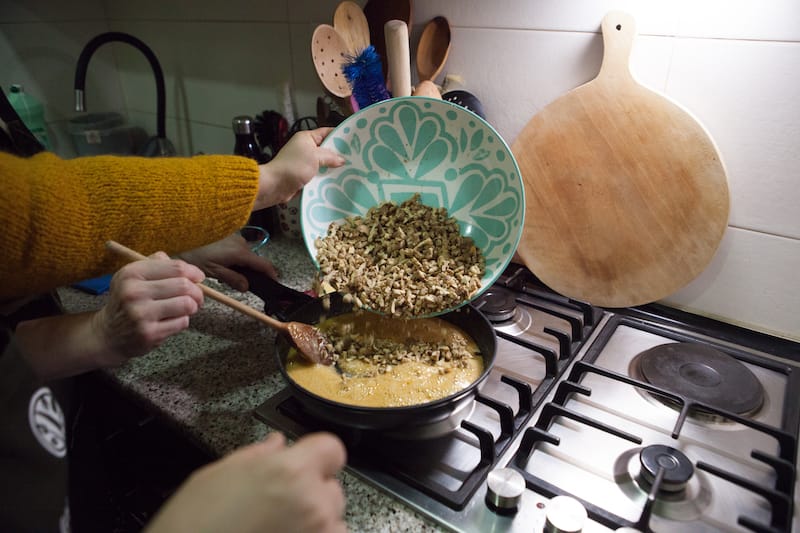 Once the honey is caramelized, add the walnuts, keeping the pan on low heat. Mix the walnuts thoroughly until they are all well-coated in honey. “Compared to the walnuts, there is very little honey. That's the key, and that's the main mistake people make,” says Irma. “When they use lots of honey and less walnuts, [the mixture] becomes runny and doesn't set properly.” If you have a lot of liquid honey left in the pan, you can use a spoon to crush the walnuts slightly and even out the spread. Next, take this shining mass of honeyed walnuts and carefully empty it onto a wooden cutting board. It will be very sticky and hot, so do not touch it! It will be easy to remove from the board once it has cooled, but may stick at this stage.
Once the honey is caramelized, add the walnuts, keeping the pan on low heat. Mix the walnuts thoroughly until they are all well-coated in honey. “Compared to the walnuts, there is very little honey. That's the key, and that's the main mistake people make,” says Irma. “When they use lots of honey and less walnuts, [the mixture] becomes runny and doesn't set properly.” If you have a lot of liquid honey left in the pan, you can use a spoon to crush the walnuts slightly and even out the spread. Next, take this shining mass of honeyed walnuts and carefully empty it onto a wooden cutting board. It will be very sticky and hot, so do not touch it! It will be easy to remove from the board once it has cooled, but may stick at this stage.
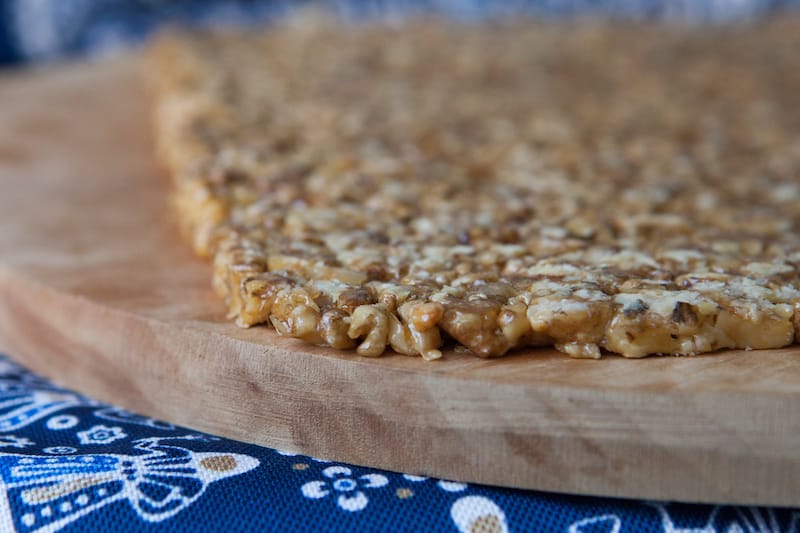 When the mixture has cooled a little, dampen your hands and a rolling pin with water and start rolling it into a flat rectangle. Dampening the rolling pin helps to prevent it from sticking, but you may also need a knife on hand to scrape the rolling pin off and push the edges in for a more consistent shape. “You want it to be half a centimeter thick,” says Irma, “But that's your personal preference; some people love thin gozinaki, [others prefer] it thick.”
When the mixture has cooled a little, dampen your hands and a rolling pin with water and start rolling it into a flat rectangle. Dampening the rolling pin helps to prevent it from sticking, but you may also need a knife on hand to scrape the rolling pin off and push the edges in for a more consistent shape. “You want it to be half a centimeter thick,” says Irma, “But that's your personal preference; some people love thin gozinaki, [others prefer] it thick.”
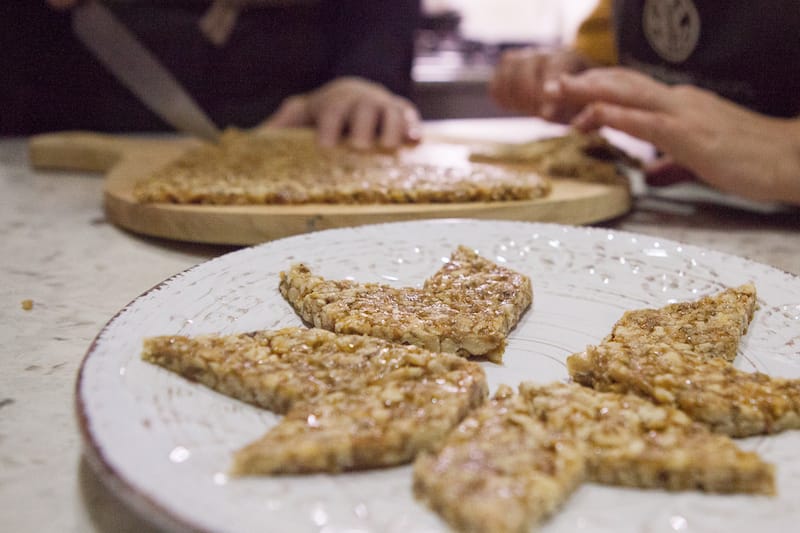 Keep rolling and pressing until you reach your desired thickness, and then let the mixture cool a little longer. The final step is cutting the gozinaki into the traditional diamond shape. With a sharp knife, cut straight lines about five centimeters apart along the length of the rectangle. Then turn your cutting board and cut diagonal lines across your rectangle at the same distance apart. This will produce even diamond shapes which you can gently ease apart and lay out flat to cool fully. Some parts may hold heat for longer and will need more time to cool down and solidify.
Keep rolling and pressing until you reach your desired thickness, and then let the mixture cool a little longer. The final step is cutting the gozinaki into the traditional diamond shape. With a sharp knife, cut straight lines about five centimeters apart along the length of the rectangle. Then turn your cutting board and cut diagonal lines across your rectangle at the same distance apart. This will produce even diamond shapes which you can gently ease apart and lay out flat to cool fully. Some parts may hold heat for longer and will need more time to cool down and solidify.
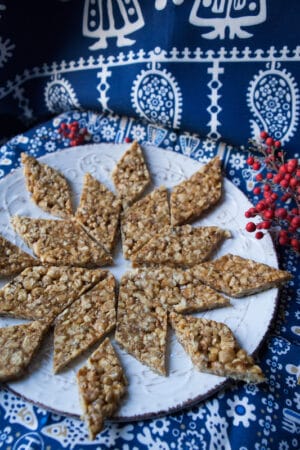 Once the pieces have cooled, you are ready to remove them from your board and arrange them on a plate to enjoy with guests. If your gozinaki are still sticking to the board, you can give them a little more time to cool or slide a palette knife or spatula between the gozinaki and the board to help lift them off. Any leftovers can be stored in a glass container in a cold place and will keep for around two weeks. Placing parchment paper between the layers of gozinaki will help prevent the pieces from sticking.
Once the pieces have cooled, you are ready to remove them from your board and arrange them on a plate to enjoy with guests. If your gozinaki are still sticking to the board, you can give them a little more time to cool or slide a palette knife or spatula between the gozinaki and the board to help lift them off. Any leftovers can be stored in a glass container in a cold place and will keep for around two weeks. Placing parchment paper between the layers of gozinaki will help prevent the pieces from sticking.